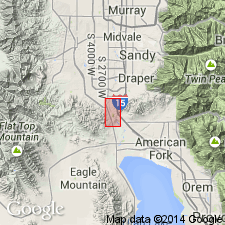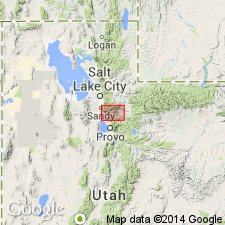
- Usage in publication:
-
- Traverse volcanics
- Modifications:
-
- First used
- Dominant lithology:
-
- Volcanics
- AAPG geologic province:
-
- Wasatch uplift
Summary:
First published use of name in Jordan Narrows and Oquirrh foothills, Salt Lake Co, UT on the Wasatch uplift, as the basal formation of Salt Lake group. Intent to name, source of geographic name [probably the Traverse Mountains], and type locality not stated. Shown on figure as 1,000 to 3,000 ft thick and as intertonguing with the overlying Jordan Narrows unit, an informal unit (new) of the Salt Lake. Underlying formation not discussed. Lithology not described. Shown on figure as ranging from early Oligocene to early Miocene. [Not adequately described for a new name.] Geologic map.
Source: GNU records (USGS DDS-6; Denver GNULEX).

- Usage in publication:
-
- Traverse Volcanics*
- Modifications:
-
- Geochronologic dating
- AAPG geologic province:
-
- Wasatch uplift
Summary:
A date of 37.3 +/-1.1 m.y. obtained from biotite from the Traverse Volcanics in Lehi quad, Salt Lake Co, UT on the Wasatch uplift. Is part of the earlier phase of volcanism in the Bingham area.
Source: GNU records (USGS DDS-6; Denver GNULEX).
For more information, please contact Nancy Stamm, Geologic Names Committee Secretary.
Asterisk (*) indicates published by U.S. Geological Survey authors.
"No current usage" (†) implies that a name has been abandoned or has fallen into disuse. Former usage and, if known, replacement name given in parentheses ( ).
Slash (/) indicates name conflicts with nomenclatural guidelines (CSN, 1933; ACSN, 1961, 1970; NACSN, 1983, 2005, 2021). May be explained within brackets ([ ]).

